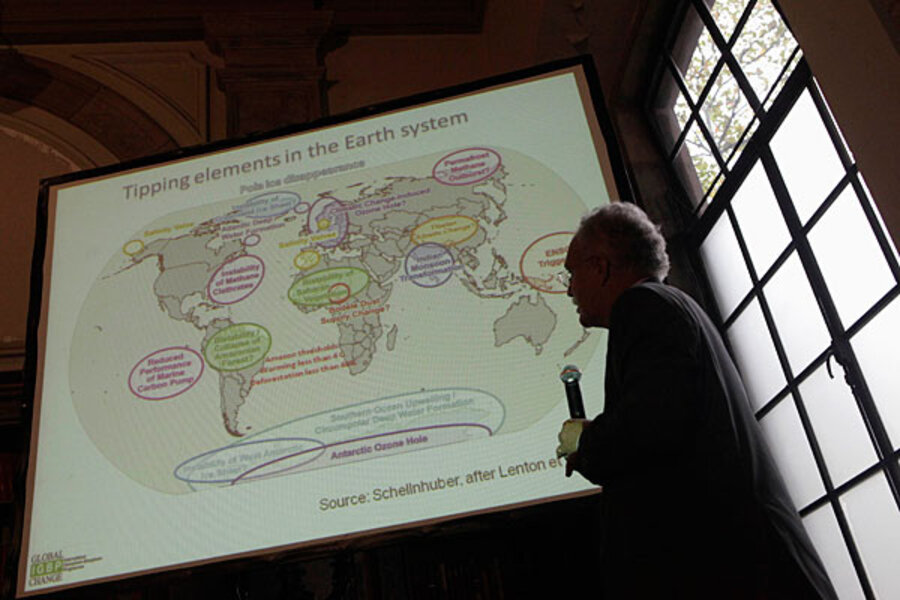Report: Humans near tipping point that could dramatically change Earth
The variety and distribution of plants and animals on Earth – and, for many species, prospects for survival – may be nearing an abrupt, fundamental change because of human activity, warns an international team of ecologists and biologists.
Unless humanity deals with the underlying causes that could be pushing Earth's biosphere toward such a change, the results could lead to social and economic instability, write the researchers in a study unveiled Wednesday in the journal Nature.
The underlying triggers that the researchers say could lead to a global ecological tipping point have a familiar ring: population growth and the resulting thirst for resources, with their effects on land use, climate, and habitats.
The research, with related studies, are part of a package the journal pulled together in advance of the UN Conference on Sustainable Development scheduled for June 20-22 in Rio de Janiero. The meeting marks the 20th anniversary of the "Earth Summit," as the first Rio sustainable-development conference was dubbed.
Scientists have sounded warnings about the effects of habitat destruction, global warming, and other changes humans have wrought on their surroundings for years. Moreover, the notion of tipping points long has been applied to climate, as well as ecology, at least on a local or regional scale.
But for ecology, "the new twist here is that rather than thinking about individual parts of the system, we began to think about the biosphere as a whole," says Anthony Barnosky, a biologist at the University of California at Berkeley and the study's lead author.
While the conclusion is sobering, he adds that, "We are a clever species. We have the solutions to these kinds of problems in our grasp."
Among them: Reducing reliance on fossil fuels, make more efficient use of existing farmland and distribute food more effectively, and beef up efforts to establish and maintain what the team calls reservoirs of biodiversity – broad, relatively pristine ecosystems rich in species.
Key to this, however, is reducing population growth rates, the team holds. Other researchers have found that good education for women and enhancing their economic opportunities can play crucial roles in this effort.
The team is frank about the uncertainties involved. It's unclear if such a shift is inevitable, and if it is, how much time remains before it happens, the researchers say. The team was thinking in terms of 50 to 100 years, Dr. Barnosky says, but he adds that the state of the science and of ecological forecasting isn't up to the task of answering those questions yet for the globe as a whole.
But the globe's biosphere has undergone significant changes before – most recently and most rapidly as it emerged from the last ice age, which ended some 12,900 years ago. Most of the ecological changes took place within the first 1,600 years of deicing, the researchers say.
The team took that event as its benchmark for measuring global changes currently underway at the hands of humans. In addition, the researchers drew on a range of field studies and theoretical work published during the past decade – but largely over the last four years – shedding light onto the issue of ecosystems, tipping points, and human activities.
The short take: "What's going on today is much more dramatic and much more intense" that the changes the landscape underwent as the continental glaciers melted, Barnosky says.
Globally, the proportion of land humans have farmed, paved, logged, and developed has reached a collective 43 percent of Earth's land surface. The retreat of the glaciers affected about 50 percent. At current rates of landscape alteration, humans will have overhauled roughly 50 percent of the planet's land area by 2025, when the global population is expected to reach 8.2 billion, the team estimates.
The 50 percent number could be important if studies of smaller-scale ecosystems are any indication. These studies have found that if 50 to 90 percent of a patch of land is heavily altered, the change can trigger wholesale changes in neighboring, relatively pristine patches as well, the team notes. For most of the ecosystems studied so far, though, the figure is closer to 50 than 90, Barnosky says.
Data are more sparse for oceans, the researchers acknowledge, which remain a frontier for studying ecological tipping points.
Global warming alone is projected to affect roughly 30 percent of the Earth in ways that would require species to migrate at rates higher than those inferred from the fossil record as they spread during the end of the last ice age, the researchers note. Meanwhile, from interstate highways to urban sprawl, humans have erected more barriers to that migration.
The researchers call for beefed up efforts to monitor changes and develop ecological-forecasting tools that could help society anticipate what otherwise might be ecological surprises stemming from human-driven changes to the biosphere.






